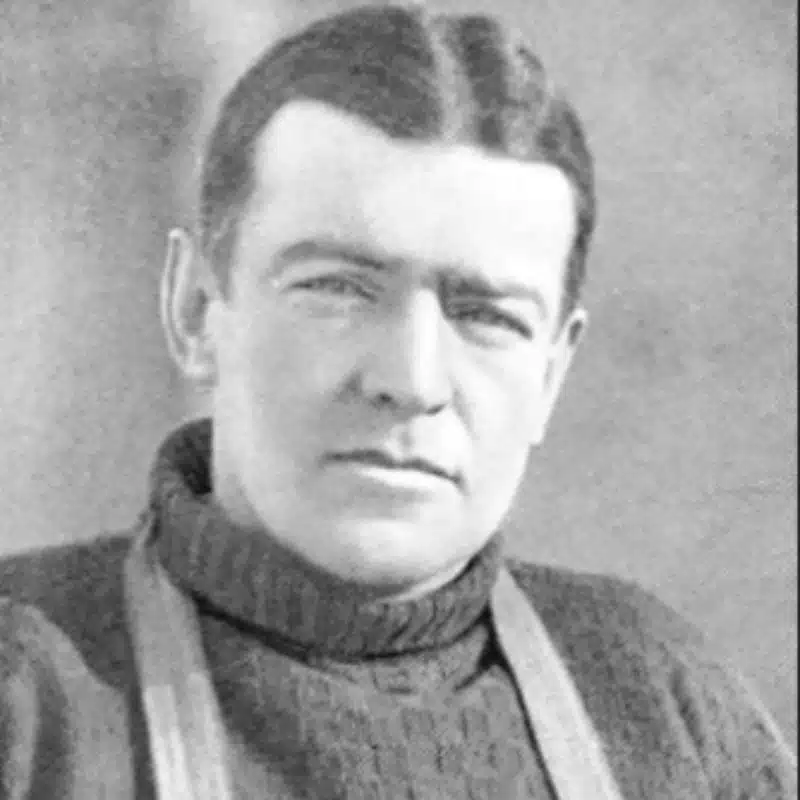The “boss” of polar expeditions in Antarctica
Sir Ernest Shackleton (1874-1922) embodies the heroic age of polar exploration, alongside the likes of Robert Falcon Scott, Roald Amundsen, and Jean-Baptiste Charcot. The exploits accomplished during his expedition to Antarctica aboard the Endurance in 1915 propelled him to the rank of legend. An epic immortalised by the first exploration documentary film ever made.
A taste for adventure
A fierce optimist and charismatic leader, Ernest Shackleton fulfilled all the criteria of a meritocratic hero in an England still partitioned by castes. The son of a doctor, he was born in Ireland on 15 February 1874 – the same year as another history-making leader, Winston Churchill.
Although nothing predestined him for it, Ernest Shackleton joined the merchant navy as a cadet at the age of 16. Until his premature death in 1922, he participated in three polar expeditions to Antarctica, which figured among the most significant in the history of the “race to the pole.”
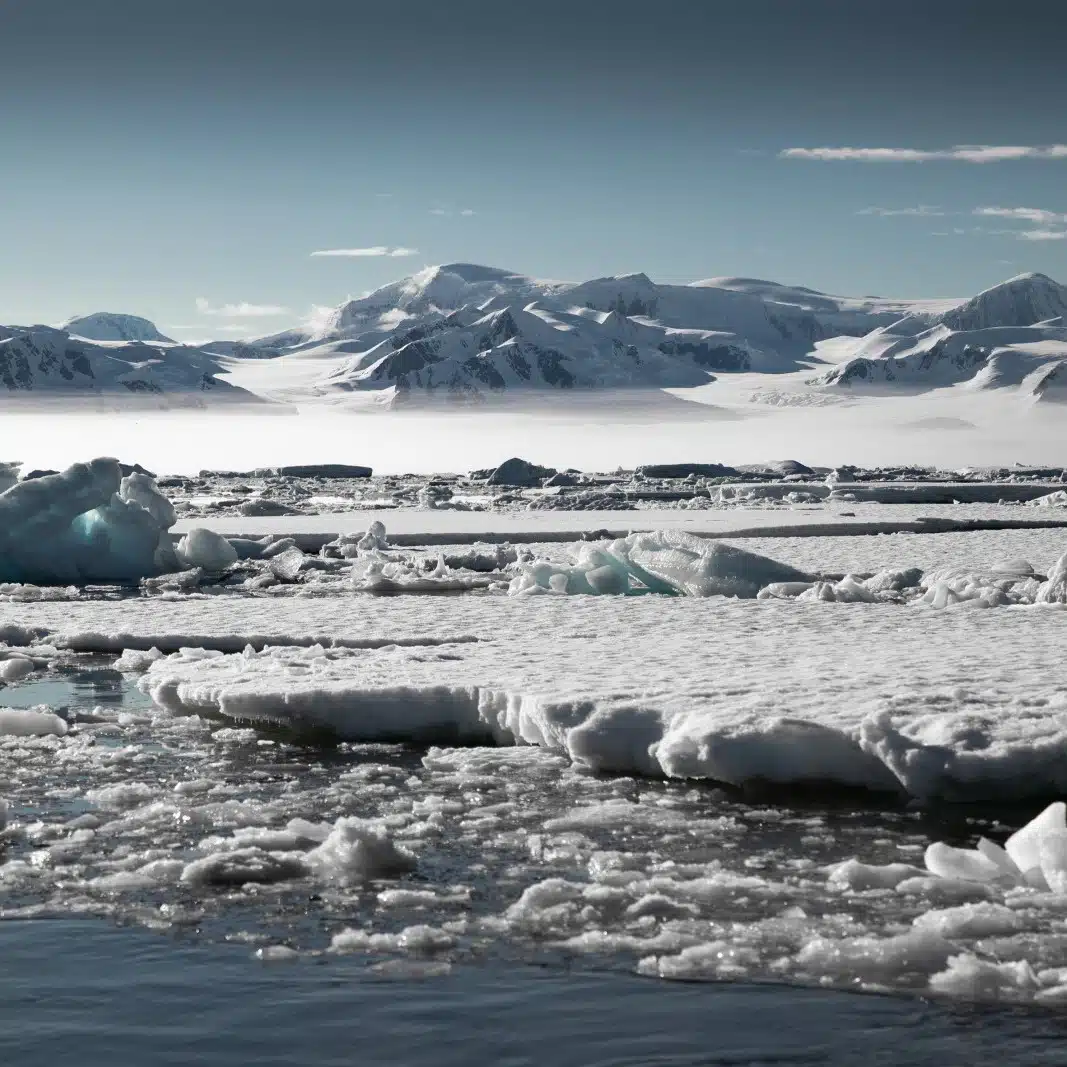
The Discovery expedition: first contact with Antarctica
At the age of 27, Ernest was appointed third officer on RRS Discovery, and took part in the first all-British polar expedition of the 20th century. Led by Robert Falcon Scott, the company aimed to explore the Ross Sea; this vast bay located in the Pacific Ocean, west of the Antarctic continent, was the closest gateway to the pole.
In November, he joined Scott and Edward Adrian Wilson in a gruelling march to push back the highest latitude ever reached by man. Suffering, he was forced to repatriate in 1903. This aborted attempt only strengthened his desire for try again.
The Nimrod expedition: in pole position
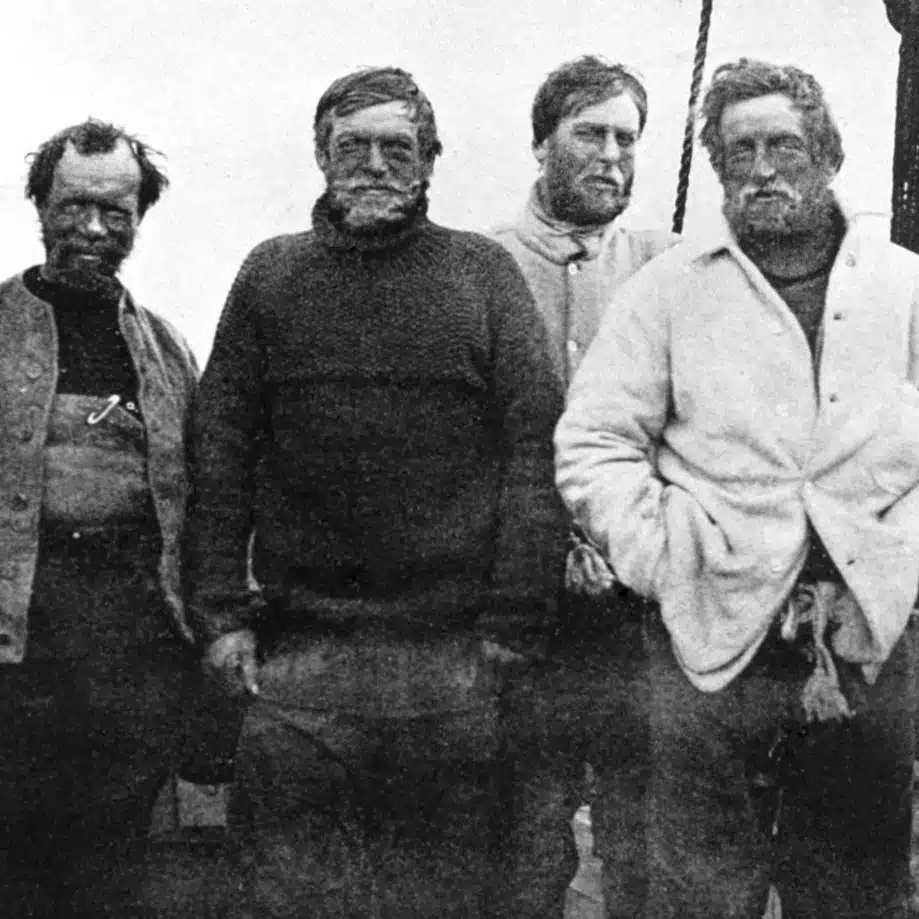
From left to right: Frank Wild, Ernest Shackleton, Eric Marshall and Jameson Adams during the Nimrod expedition.
Ernest Shackleton’s determination paid off. In 1908, he embarked as leader of the Nimrod expedition, the second British Antarctic expedition of the 20th century. His ambition? The discovery of the magnetic South Pole, the exploration of the Ross Sea ice shelf, and of course, the geographic South Pole.
Departing from New Zealand on 1 January 1908, Nimrod – the name inspired by the first king after the flood in Genesis – reached Cape Royds, on the east coast of Ross Island. Ernest Shackleton and his men then embarked on an ambitious trek to reach the South Pole. Forced to turn around after more than 2,000 kilometres travelled in 91 days, they nevertheless reached the latitude of 88°23’S, going below the symbolic bar of 100 miles to the South Pole.
Two other records were achieved during the Nimrod expedition: the first ascent of Mount Erebus, the southernmost active volcano in the world, and reaching the approximate location of the magnetic South Pole.
Welcomed home as a hero in England in 1909, Ernest Shackleton was knighted by King Edward VII. He published The Heart of the Antarctic, a detailed account of his expedition which remains among the most significant works of the heroic age of Antarctic exploration. His adventures fascinated the public, and attracted several thousand visitors on board Nimrod, moored in London.

Ernest Shackleton’s hut at Cape Royds, Ross Island.
Ernest Shackleton’s hut at Cape Royds: in the footsteps of the Nimrod expedition
Built during the Nimrod British Antarctic Expedition, the ten by six metre hut was restored in the early 2000s by the Antarctic Heritage Trust, an association which works for the conservation of historic sites in Antarctica.
The inside of this shelter, in which the 15 men of the expedition wintered for 13 months, includes a dark room with photography equipment, food, a biology laboratory, stove, table, scientific equipment, beds and personal effects of the members of the expedition, and seven gas lamps. Outside there was a stable for the ponies, a garage, and a workshop for the first car to be driven in Antarctica, an Arrol -Johnston.
The “race to the pole”
At the beginning of the 20th century, the “race to the South Pole” was in full swing. It was reached on 14 December 1911 by the Norwegian Roald Amundsen, closely followed by Scott‘s Terra Nova expedition, which was to prove fatal to him.

[He has] as his mausoleum all the fantastic architecture of Antarctica, an immense tomb that an Egyptian pharaoh could not even have dreamed of, and at the summit of the world, dominating everything.
Tribute from Commander Jean-Baptiste Charcot to Scott’s heroism
(Le Matin, 11 February 1913).
While the pole had been reached, Antarctica had never been crossed. Ernest Shackleton then prepared to embark towards the deep South to be the first imperial trans-Antarctic expedition and to connect the Weddell Sea to the Ross Sea. He renamed Polaris, a vessel specially designed for polar expeditions, Endurance, an inspiration which proved prophetic.
To recruit his crew, he placed an ad in the newspapers. He received nearly 5,000 applications.

Men Wanted: For hazardous journey. Small wages, bitter cold, long months of complete darkness, constant danger, safe return doubtful. Honour and recognition in case of success.
Ernest Shackleton
The Endurance expedition: Ernest Shackleton becomes a legend
Endurance took on board 28 crew members, nearly 70 dogs, several tons of food, and set sail on 8 August 1914 for South Georgia. Caught in ice in the Weddell Sea from January 1915, in what Ernest Shackleton described as “the worst portion of the worst sea in the world,” the ship drifted until October, endlessly trapped, waiting for a thaw that would never come.

Endurance, stuck in the ice floe in the Weddell Sea.
The expedition leader had to work to counteract the boredom weighing on the crew. Above all, it was necessary to avoid tensions, which could turn into riots, by organising hunting and even football matches on the ice, a form of entertainment vital to the spirit of camaraderie.
After drifting for more than eight months in the ice, on 21 November 1915, Endurance sank. The hull gave way in the vice-like grip of the ice floe. Following the sinking, the man his crew nicknamed the “boss,” guided his men on an epic journey that defies belief. Ernest Shackleton had two objectives, namely to attempt a return on foot and by canoe to the whaling stations of South Georgia, more than 800 miles away, where he hoped to find help, and to ensure the morale of the group to avoid any risk of mutiny.
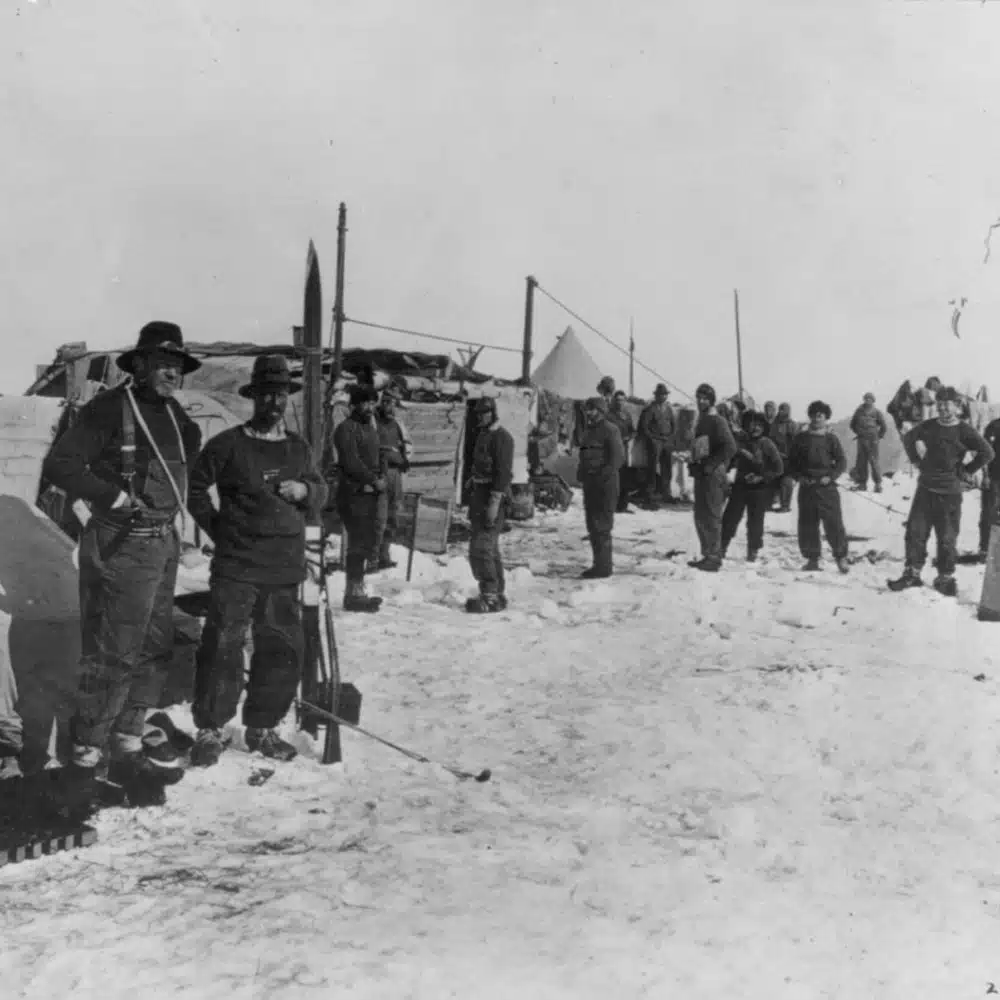
Sir Ernest Shackleton and his crew at “Ocean Camp.”
The crew first set up an initial camp on the ice floe near the wreck of Endurance known as “Ocean Camp.” Then, when the ice became too thin, the temporary installation was moved and renamed “Patience Camp.” The men survived for several months, in the hope that the drifting ice would bring them closer to the Antarctic Peninsula. The expedition leader knew of a stone hut which contained food, built on Paulet Island by survivors of the Swede Otto Nordenskjöld’s expedition that was shipwrecked in 1903.
In April 1916, the effects of the ice breakup caused the ice floe to break. Ernest Shackleton gave the order to board the boats and sail towards the nearest land, Elephant Island. He immediately left for South Georgia with four companions on board the largest of the boats, James Caird. They endured the tumults of a storm in the Weddell Sea before reaching the shores of the archipelago two weeks later.
Exhausted, they still had to climb peaks of over 3,000 metres in order to reach the whaling station of Stromness. Ernest Shackleton then organised the rescue of the rest of his crew with the assistance of the Chilean navy, and on 30 August 1916, on his return to Elephant Island, he discovered that his men had all survived despite the extreme conditions and the few resources at their disposal.

He is a man who, although clearly aware of the difficulties, always undertakes an enterprise with the absolute confidence that he can, that he must, overcome them. It is undoubtedly the contagion of this trust which makes his seconds and his men cooperate so closely with him.
Emily Shackleton
June 1916
On their return to Europe, all the newspapers carried the story of this epic adventure, but the war overshadowed it. Ernest Shackleton confided in May 1917: “Talk about my expedition? I almost hesitate. Everything has, in fact, so to speak, disappeared in the face of this war, which alone matters.” The men of the Endurance, health permitting, joined the allied forces.
The wreck of Endurance, an underwater treasure
In March 2022, members of the “Endurance22” project found the wreck of the ship in the Weddell Sea, 3,000 metres deep and six kilometres from the site of where it sank. Using cutting-edge technology, the team was able to explore the seabed with autonomous underwater vehicles, which enable 3D modelling and full photogrammetric coverage of the vessel. The photos reveal that the rudder and some of the ropes appear intact, this remarkable preservation made possible by the freezing temperatures.
The Quest Expedition: Ernest Shackleton’s last adventure
Those long months of survival on the ice floe did not in any way dampen the explorer’s ambitions. Less than a year after his return, when asked about the possibility of a fourth voyage, he replied, “Is the war over? Well, if I survive, the pole still has an irresistible attraction for me.”
He embarked on a fourth expedition which finally bore his name, Shackleton-Rowett, aboard Quest. This quest would be his last. Victim of two heart attacks, he died the day after his arrival in South Georgia, on 5 January 1922. His wife sent a telegram to say that she did not wish the body to be repatriated, believing that her husband would like to rest in the whaling cemetery of Grytviken, near the white continent to which he devoted his life.

Grave of Ernest Shackleton, Grytviken Whaling Cemetery, South Georgia
South, the first exploration documentary
Frank Hurley (1885-1962), an Australian adventurer and filmmaker aboard Endurance, filmed this incredible adventure on his camera, from the endless wait to the rescue of those shipwrecked. On his return, he put his name to South (1919), considered the first exploration documentary. The eponymous documentary, The Endurance, directed by George Butler and released in 2000, looks back on the expedition using archival footage shot by Frank Hurley, plus testimonies from families of the survivors.
Photo credits: © F. Hurley, Underwood & Underwood; ©James Murray; ©PONANT/Photo-Ambassador Cindy Miller Hopkins; © StudioPONANT /Morgue Monneret ; © StudioPONANT /Adrien MORLENT
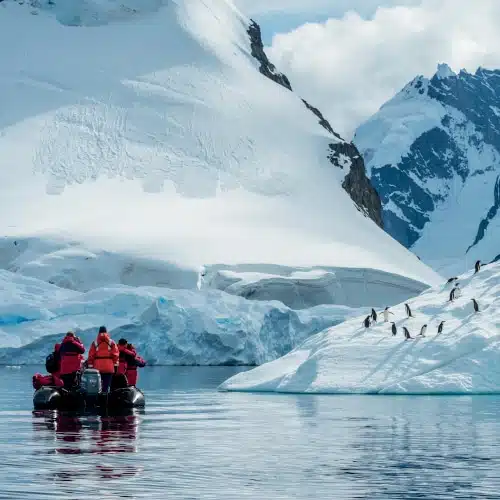
Navigating the history of polar exploration
Embark on an expedition to Antarctica

